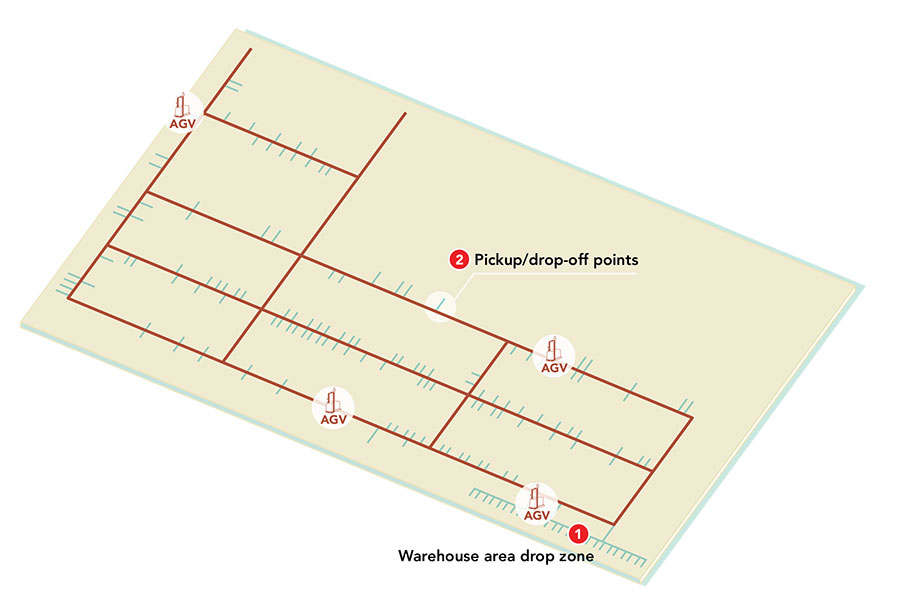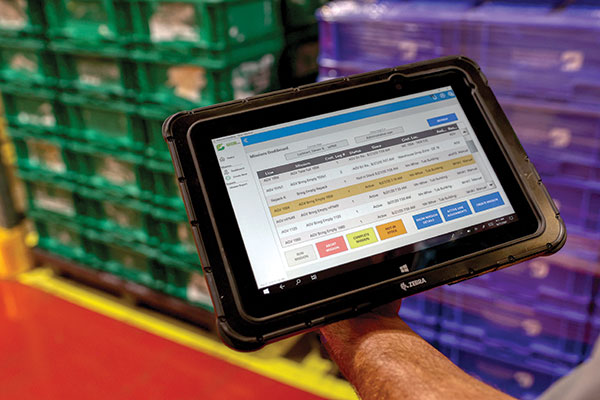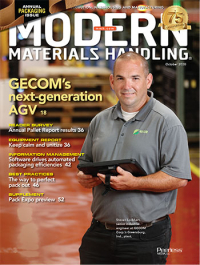Inside the GECOM Plant: A new take on AGVs
A fleet of five AGVs links the production line with finished goods storage.
Location: Greensburg, Ind.
Size: AGVs operate in a 50,000-square-foot area
Throughput: Each AGV averages 129 missions in 24 hours
Products Handled: Tubs of finished goods and empty finished good tubs
Shifts Per Day/ Days Per Week: 3 shifts, 5 days a week
At GECOM’s Indiana plant, automatic guided vehicles (AGVs) are using a next-generation navigation system to deliver empty totes to the production line and finished goods to the warehouse. The fleet of five vehicles service 65 assembly lines.
GECOM refers to a task for the AGVs as a mission. Missions are downloaded to a server, known as the ANT server, and are prioritized to minimize the amount of empty travel by the vehicles.
There are two types of missions: The AGVs deliver pallets of empty tubs to the assembly line and also pick up full tubs with finished goods for delivery to the warehouse.
Empty tub drop off: The process begins when a team leader logs into Ignition, the SCADA software system. The team leader picks an assembly line that needs a pallet of empty tubs and dunnage. When the team leader starts the mission, instructions are delivered to a warehouse team (1) whose job is to retrieve a pallet of tubs required for that mission and stage them for pickup at a drop zone. Once the pallet is ready for pickup, the team closes out that task. The system then creates a mission for one of the AGVs to pick up the pallet of empty tubs and deliver it to one of 65 assembly lines (2).
Full tub pickup: The pickup process is similar to the drop off process. A team leader initiates a mission in the tablet to pick up the full pallet at the specified line and deliver it to one of 26 possible drop-off locations in the warehouse area. Red, green and yellow lights notify warehouse workers and the AGVs/production side about activity in the area. Each drop-off location has a light on the warehouse side and one on the AGV/production side. A green light indicates that a bay is open for a drop. A solid yellow light indicates that the drop is occupied by something and is not available. A flashing yellow light indicates that the AGV is enroute to that location, which tells everyone not to put anything in that location.
A flashing red light on the warehouse side tells the warehouse team that the AGV has just dropped off at that location and will be solid red on the AGV/production side. When the warehouse closes out a “bring empty mission” the light will flash red on the AGV/production side and will be solid on the warehouse side. So, at a quick glance of the drop zone someone will be able to tell how full the drop zone is with either empty tubs or finished product. Being able to separate AGV and fork truck traffic creates a safety factor for the team.
Once an AGV drops a pallet, either at the line or the warehouse, the system knows that vehicle is available for the next mission.


Article Topics
AGVs and AMRs News & Resources
2024 Intralogistics Robotics Survey: Robot demand surges Autonomous mobile robots (AMRs) on a mission K.Hartwall and its Australian distribution partner, Retailquip, join forces Pramac partners with BlueBotics to launch line of ANT driven mobile robots Mitsubishi Logisnext partners with Jungheinrich to introduce Rocrich AGV Solutions CaPow’s power-in-motion solution eliminates charging downtime Conveyco unveils All-Temp AMRs that can move between frozen, chilled and ambient warehouses More AGVs and AMRsLatest in Materials Handling
NetLogistik partners with Vuzix subsidiary Moviynt to offer mobility solutions for warehouses Materials Handling Robotics: The new world of heterogeneous robotic integration Lucas Watson appointed CSO for Körber’s Parcel Logistics business in North America Hyster recognizes Dealers of Distinction for 2023 Carolina Handling names Joe Perkins as COO C-suite Interview with Keith Moore, CEO, AutoScheduler.AI: MODEX was a meeting place for innovation Walmart deploying autonomous lift trucks at four of its high-tech DCs More Materials HandlingAbout the Author
Subscribe to Materials Handling Magazine

Find out what the world's most innovative companies are doing to improve productivity in their plants and distribution centers.
Start your FREE subscription today.
April 2024 Modern Materials Handling

Latest Resources












